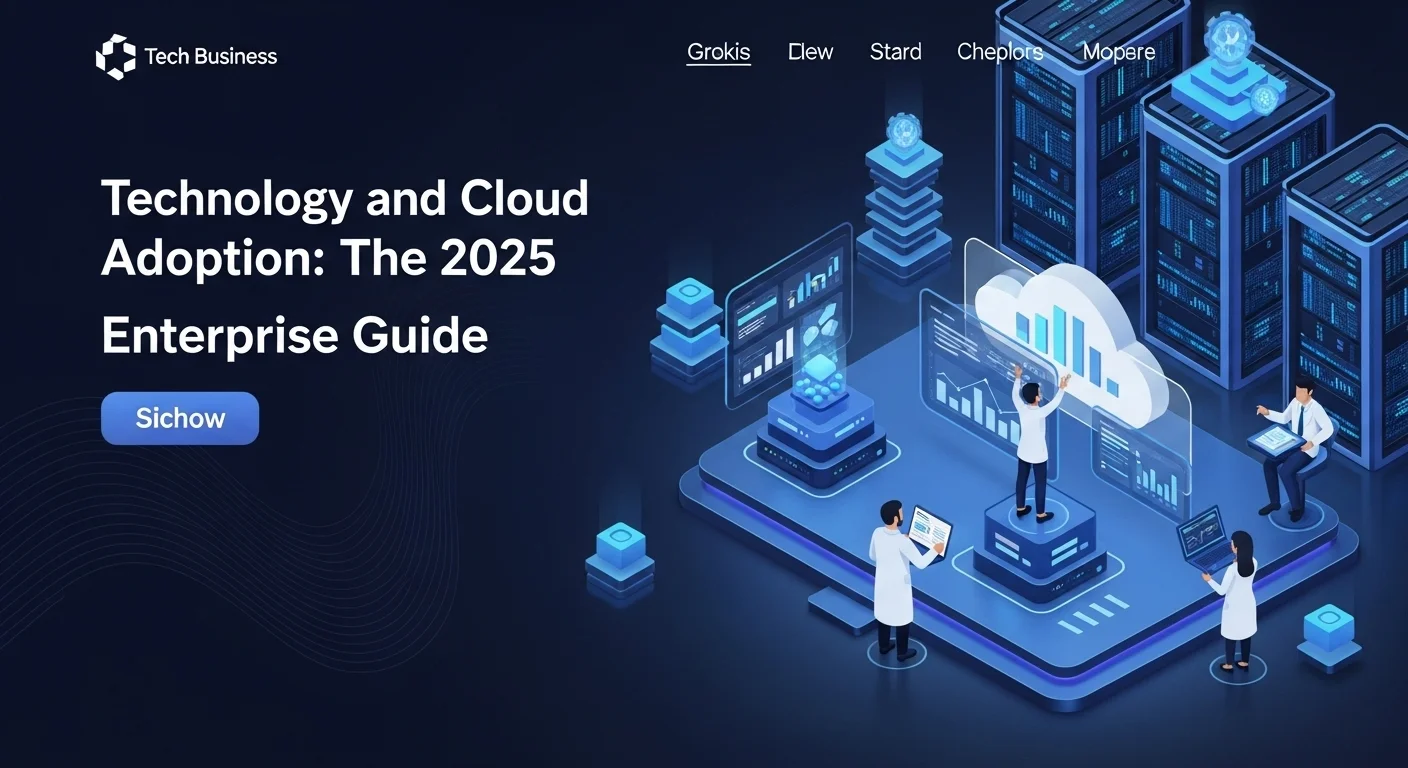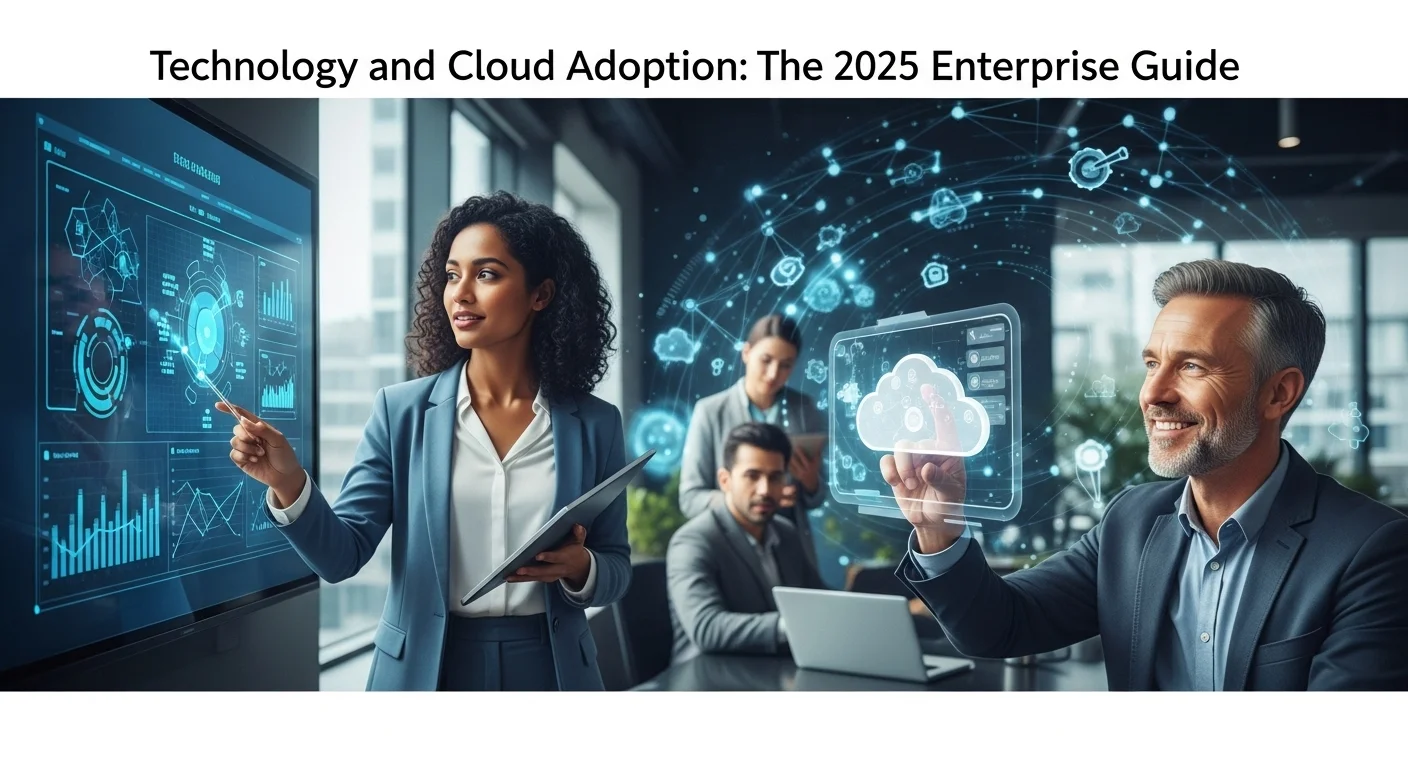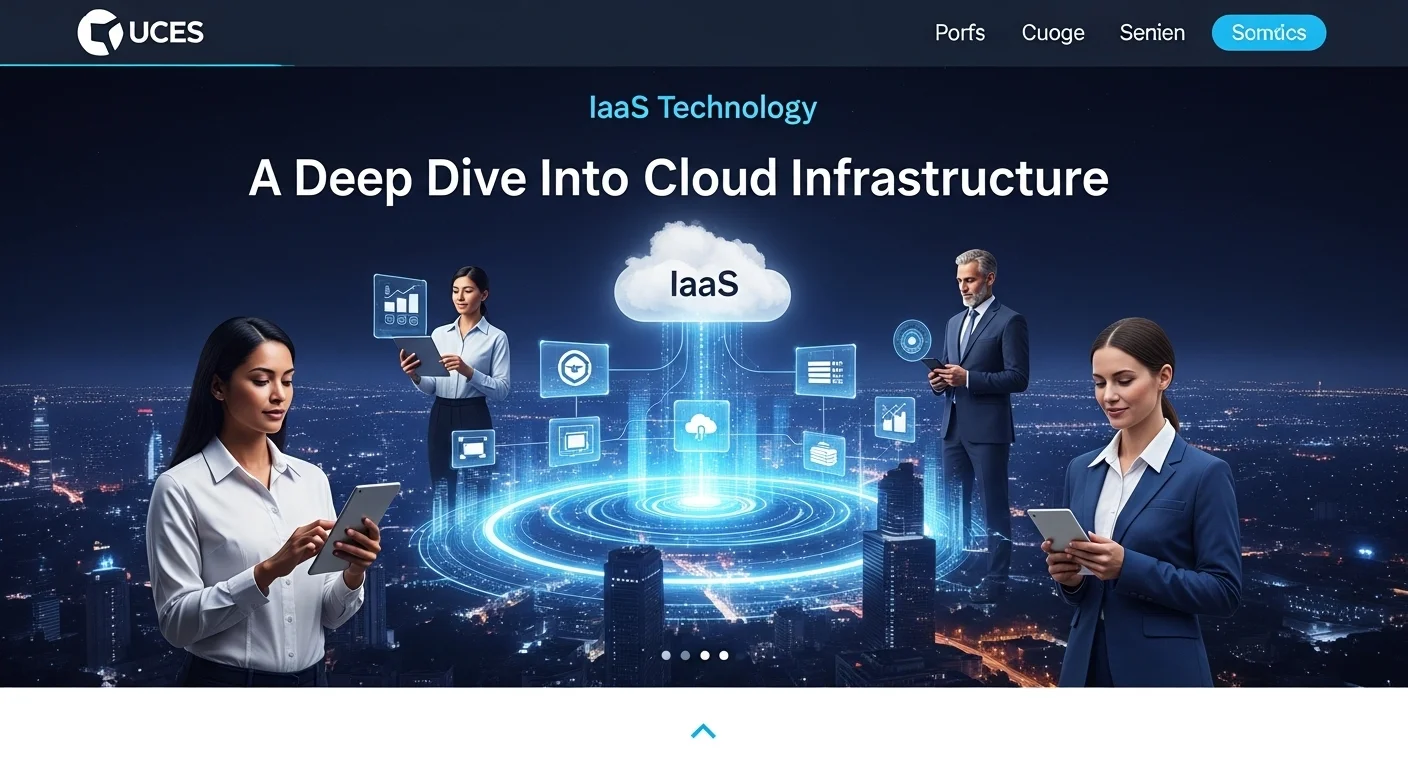Mastering Cloud Adoption: A Practical Guide for Your Business in 2025

Executive Summary
I've spent years helping businesses move to the cloud, and let me tell you, it's more than just a tech upgrade—it's a complete game-changer for how you operate. Cloud adoption is the strategic shift from running your own servers in a back room to using powerful, flexible, and efficient cloud services. This article is my personal guide to help you navigate this journey. We'll start with the basics, like the difference between IaaS, PaaS, and SaaS, and explore the right cloud model for you—be it public, private, or a hybrid approach. I'll also break down what industry giants like Gartner and McKinsey are saying about the trillions of dollars in value at stake. This isn't just about saving money; it's about unlocking new levels of innovation and agility. Whether you're a large enterprise or a growing business, this is your resource for making the cloud work for you.
Table of Contents
Table of Contents
- What is Cloud Adoption and Why is it So Important?
- The Building Blocks: Cloud Models and Services Explained
- What the Experts at Gartner & McKinsey Say
- Why Moving to the Cloud is a Game-Changer for Enterprises
- A Complete Guide to Cloud Solutions for Your Business
- Your Blueprint for Success: Cloud Adoption Frameworks (CAFs)
- The '6 Rs' of Migration: Your Strategic Options
- Connecting Tech and Business: A Unified Approach
- Tips and Strategies to Maximize Your Cloud Experience
- Best Practices for a Healthy Cloud Environment
- Advanced Strategies for Real Innovation
- What's Next? The Future of the Cloud
What is Cloud Adoption and Why is it So Important?
In all my years in tech, I've never seen a shift as massive as the move to the cloud. Cloud adoption is the process businesses go through to move their work—their data, applications, and IT resources—into the cloud. This isn't just a trend; it's a fundamental business decision that defines how modern companies innovate and compete. At its heart, it’s a change in philosophy. You stop spending huge amounts of money on physical servers you have to maintain (a capital expense, or CapEx) and switch to a flexible, pay-as-you-go model where you rent the exact services you need (an operational expense, or OpEx). From my experience, this single shift gives companies a level of speed and scalability we could only dream of a decade ago.
You really can't overstate how crucial the cloud is today. It's the engine that powers almost every major modern technology, including Artificial Intelligence (AI), Big Data, and the Internet of Things (IoT). These fields demand enormous computing power that's just not practical to host yourself. The cloud makes these powerful tools accessible to everyone, from small startups to global corporations, leveling the playing field. More than that, embracing the cloud is the key to true digital transformation. It helps you break down internal barriers, improve teamwork, and deliver the smooth, personalized experiences your customers expect. In today's market, the ability to quickly build and update your services is what keeps you ahead, and the cloud makes that possible.
The Building Blocks: Cloud Models and Services Explained
To really get a handle on cloud adoption, you need to know the basic building blocks. I like to explain it with a pizza analogy to my clients. Cloud services come in three main flavors:
- Infrastructure as a Service (IaaS): This is like buying the pizza ingredients, the flour, the sauce, the cheese, and using the provider’s oven to make it yourself. You rent the fundamental IT infrastructure—servers, storage, networks—from a provider like AWS or Azure. It gives you the most control, just like having your own virtual data center.
- Platform as a Service (PaaS): This is like getting a take-and-bake pizza kit. The provider gives you the platform—the database, development tools, operating system—so you can focus on creating your app (or your pizza masterpiece) without worrying about managing the underlying hardware.
- Software as a Service (SaaS): This is simply ordering a pizza delivered to your door. You subscribe to a software application over the internet, like Salesforce, Gmail, or Microsoft 365. The provider handles everything, from the software itself to all the maintenance and security. You just use it.
On top of these services, you have to choose how you want your cloud deployed. The main options are:
- Public Cloud: This is the most common model, where you use services from a provider like AWS, Google Cloud, or Microsoft Azure. It's incredibly scalable and cost-effective because you share the infrastructure with other customers.
- Private Cloud: These are cloud resources used exclusively by one company. Think of it as your own personal cloud, which can be located on-site or hosted by a third party. This is often the choice for organizations with very strict security or compliance needs, like banks or government agencies.
- Hybrid Cloud: This approach gives you the best of both worlds. It combines a private cloud with a public cloud, letting you keep sensitive data secure while using the public cloud's power for less critical tasks. I've seen this strategy work wonders for businesses that want flexibility and control.
What the Experts at Gartner & McKinsey Say
Don't just take my word for it. The biggest names in business research have been analyzing the move to the cloud for years, and their findings make a powerful case for why it should be a top priority.
Gartner, a leading research firm, sees the cloud as the absolute center of modern digital strategy. They've found that it's not just a technology but a force that's changing how businesses operate. They predict that by 2025, almost all new digital work will happen on cloud-native platforms. But they also offer a word of caution I've seen play out in real life: many companies become 'cloud dissatisfied' because they jump in without a clear plan, leading to messy migrations and runaway costs. A solid strategy is everything.
Then you have McKinsey, which focuses on the bottom-line value. Their research is mind-blowing—they estimate that the cloud could unlock a staggering $3 trillion in business value for top companies by 2030. They argue that the real win isn't just saving a few bucks on IT costs. The magic happens when you use the cloud to innovate—to build new products faster, make smarter decisions with data, and create entirely new business models. For any large company, they stress that this has to be a full-scale transformation that involves training your people and rethinking how you work.
Why Moving to the Cloud is a Game-Changer for Enterprises
For large companies, the challenges of adopting the cloud are bigger, but so are the rewards. These organizations are often dealing with decades of old technology, complex regulations, and set-in-stone ways of working. But this is exactly why the move is so powerful. Migrating to the cloud lets enterprises finally leave behind their aging, expensive infrastructure and free up their teams to focus on creating value instead of just keeping the lights on. It gives them the speed they need to compete with smaller, nimbler startups. A successful journey for a large business often starts with a careful look at all their applications to decide which ones to move, update, or simply turn off. A hybrid model is often the perfect fit, allowing them to keep sensitive systems in a secure private environment while using the public cloud's limitless power for everything else. It’s a complex path, but the destination—a smarter, faster, and stronger business—is more than worth it.

A Complete Guide to Cloud Solutions for Your Business
Starting your cloud journey is one of the most important moves a modern company can make. It’s a lot more than just a tech project; it’s a deep strategic shift that requires careful planning, a change in culture, and a solid grasp of what your business truly needs. When done right, it unlocks a level of agility and innovation you can't get any other way. Here’s my practical guide to navigating the process, from picking the right plan to integrating it into the heart of your business.
Your Blueprint for Success: Cloud Adoption Frameworks (CAFs)
You wouldn't build a house without a blueprint, and you shouldn't move to the cloud without a framework. A Cloud Adoption Framework, or CAF, is your guide—a collection of best practices, tools, and expert advice to make your cloud journey smoother and more successful. The major cloud providers offer their own fantastic frameworks:
- Microsoft Azure Cloud Adoption Framework (CAF): I'm a big fan of Azure's structured approach. It breaks the process into clear stages: Strategy, Plan, Ready, Adopt, Govern, and Manage. It forces you to connect your cloud plans to real business goals right from the start, ensuring everyone is on the same page before you migrate a single server.
- AWS Cloud Adoption Framework (CAF): The AWS framework looks at your organization from six different perspectives: Business, People, Governance, Platform, Security, and Operations. This is great for making sure you’ve covered all your bases. It helps you find and fix gaps in skills or processes early on, which can save you a lot of headaches down the road.
- Google Cloud Adoption Framework: Google’s framework is built around a four-part journey: Learn, Lead, Scale, and Secure. It really emphasizes putting people first and creating a culture of continuous improvement. It’s all about empowering your teams with the skills and confidence to build amazing things with cloud technology.
While each framework is slightly different, they all share one common goal: to give you a proven, repeatable path for a successful cloud migration. They help you answer the tough questions and build a solid foundation for the future.
The '6 Rs' of Migration: Your Strategic Options
One of the biggest decisions you'll make is what to do with all your existing applications. The '6 Rs' model is a simple but powerful way to think about your options:
- Rehost (aka 'Lift and Shift'): This is the quickest way to the cloud. You move your applications as-is, without making any changes. It's a great choice when you need to get out of a data center fast. The downside is that you might not be taking full advantage of the cloud's features.
- Replatform (aka 'Lift, Tinker, and Shift'): Here, you make a few small tweaks to your application to get some immediate cloud benefits. A common example I see is moving a database to a managed cloud service. This can boost performance and cut down on maintenance without a major overhaul.
- Repurchase (aka 'Drop and Shop'): This means switching to a completely new, cloud-based product, usually a Software as a Service (SaaS) solution. For instance, instead of managing your own email servers, you move to Google Workspace. This frees you from managing the software and the hardware it runs on.
- Refactor / Rearchitect: This is the most involved strategy, but it often delivers the biggest rewards. You completely redesign your application to be 'cloud-native,' using modern technologies like microservices and serverless functions. You do this when you have a critical business need for more speed, scale, or new features.
- Retire: As you review your systems, you'll inevitably find some applications that are no longer used or needed. Simply turning them off can save you a surprising amount of money on licensing and support.
- Retain: Sometimes, the best move is to do nothing at all. Certain applications might need to stay on-premises due to regulations, high migration costs, or because they're just too complex to move right now. This is a key part of any good hybrid cloud strategy.
Connecting Tech and Business: A Unified Approach
From my experience, the most successful cloud projects are the ones where the tech team and the business leaders are perfectly in sync. The technical deep dive is about setting up a secure and scalable foundation for your cloud presence.
On the tech side, this could mean building a dedicated private environment with tools like VMware or OpenStack. For a hybrid approach, you need to ensure a seamless connection between your data center and the public cloud using technologies like AWS Direct Connect or Azure ExpressRoute. Key details like network design and identity management are critical to get right.
On the business side, it's all about delivering real value. This is where the advice from firms like McKinsey really hits home. They stress that the 'trillion-dollar prize' of the cloud comes from changing your operating model, not just your IT department. This means building a strong business case, fostering a culture that embraces change, and training your staff to use these new tools. Gartner echoes this, highlighting the need for strong governance and a focus on FinOps to manage cloud spending wisely. The ultimate goal isn't just to be 'in the cloud'—it's to use the cloud to become a faster, smarter, and more customer-focused company. That's how your technology investment turns into a real competitive edge.

Tips and Strategies to Maximize Your Cloud Experience
Getting to the cloud is a huge accomplishment, but the work doesn't stop there. In fact, that's where the real fun begins. The true power of the cloud comes from constant optimization, smart governance, and a forward-thinking strategy that embraces what's next. Here are my essential tips and advanced strategies to turn your cloud environment from a simple utility into a strategic advantage.
Foundational Best Practices for a Thriving Cloud Environment
Once you're in the cloud, your focus should shift to managing and improving your new setup. I always advise my clients to nail these four areas for long-term success.
1. Create a Cloud Center of Excellence (CCoE): Think of a CCoE as the control tower for your company's cloud journey. It’s a dedicated team of people from across the business—IT, finance, security, and more. Their job is to set the rules, guide technology choices, keep costs in check, and share best practices with everyone. A CCoE prevents chaos, ensures consistency, and makes sure every cloud project aligns with your main business goals.
2. Prioritize Security with the Shared Responsibility Model: Cloud security is a handshake. The provider secures the 'cloud' (their physical data centers and infrastructure), but you are responsible for security 'in the cloud' (your data, applications, and user access). Understanding this is critical. I always recommend a 'zero-trust' approach, where no one is trusted by default. Use modern tools to spot security gaps and build security directly into your development process (a practice known as DevSecOps).
3. Master Your Costs with FinOps: The cloud's pay-as-you-go model is fantastic for flexibility, but it can get expensive fast if you're not paying attention. FinOps (a mix of Finance and DevOps) is a mindset and a set of practices for bringing financial discipline to your cloud spending. The goal isn't just to slash costs, but to get the most business value out of every dollar you spend. This involves tracking your spending, optimizing resources (like shutting down unused servers), and automating as much as possible.
4. Drive Cultural Change and Train Your People: Technology is only half the story. A successful cloud adoption requires a real cultural shift. Your teams need to learn to work in more collaborative, agile ways. You have to invest in training to give your employees the cloud skills they need to succeed. This investment not only empowers your teams but also creates a culture where everyone is constantly learning and innovating.
Advanced Strategies for Real Innovation and Efficiency
- Go Cloud-Native and Serverless: To get the most out of the cloud, you need to think beyond just moving old applications. Rebuilding them to be 'cloud-native'—using technologies like containers and microservices—makes them more reliable, scalable, and easier to update. Take it a step further with 'serverless' computing (like AWS Lambda or Azure Functions), where you can run your code without thinking about servers at all. This drastically cuts down on management and costs.
- Leverage AI and Machine Learning: The cloud has made powerful AI and machine learning tools accessible to everyone. Services from Amazon, Google, and Microsoft give you everything you need to build, train, and use AI models at scale. I've seen companies use this to transform their operations, from automating tasks to getting predictive insights that lead to smarter business decisions.
- Automate Everything with Infrastructure as Code (IaC): Setting up cloud environments by hand is slow and prone to errors. IaC tools like Terraform allow you to define your entire infrastructure in code. This means you can build perfectly consistent environments with the click of a button, which dramatically speeds up your work and reduces risk.
Looking Ahead: The Future of Cloud Adoption
The cloud is always changing, and staying ahead of the curve is key. Both Gartner and McKinsey see some exciting trends on the horizon.
Gartner predicts that within the next few years, AI workloads will consume a massive chunk of cloud computing resources. They also point to the rise of 'industry clouds'—platforms tailored specifically for sectors like finance and healthcare. McKinsey’s research continues to show that the cloud will unlock enormous business value, but only for companies that use it to truly innovate. Hybrid and private cloud strategies will continue to evolve, with new technologies making it easier to manage these complex environments. The future belongs to businesses that see the cloud not as a one-time project, but as a continuous journey of improvement. To learn more from the source, the AWS Cloud Adoption Framework official page is an excellent place to start.
Expert Reviews & Testimonials
Sarah Johnson, Business Owner ⭐⭐⭐
The information about Cloud Adoption is correct but I think they could add more practical examples for business owners like us.
Mike Chen, IT Consultant ⭐⭐⭐⭐
Useful article about Cloud Adoption. It helped me better understand the topic, although some concepts could be explained more simply.
Emma Davis, Tech Expert ⭐⭐⭐⭐⭐
Excellent article! Very comprehensive on Cloud Adoption. It helped me a lot for my specialization and I understood everything perfectly.



